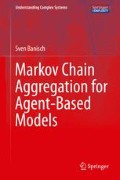Abstract
This chapter is devoted to the analysis of a simple opinion model in order to illustrate the ideas developed in the previous chapter. The projection from micro to macro emphasizes the particular role played by homogeneous mixing as a requirement for the Markovianity of the projected model. We present a Markov chain analysis of the binary voter model (VM) with a particular focus on its transient dynamics and show that the general VM can be reduced to the binary case by further projection. Finally, the question of interaction constraints in form of bounded confidence is addressed. Homogeneous interaction probabilities (homogeneous mixing) are assumed in all the analyses presented in this chapter. Interaction heterogeneities are left for the next chapters.
Access this chapter
Tax calculation will be finalised at checkout
Purchases are for personal use only
Notes
- 1.
Notice that permutation invariance is also present if “self interactions” are excluded such that ω(i, i) = 0. Then \(\omega (i,j) = 1/N(N - 1),\forall i\neq j\). For the following computations the possibility that an agent i “interacts” with itself is not excluded.
- 2.
Alternatively, one could also verify the lumpability of Y directly with respect to the micro process. Namely, as shown in Sect. 3.2, the micro chain is a random walk on H(N, δ). The group \(\mathcal{S}_{N}\) acting on the agents as well as the permutation group \(\mathcal{S}_{\delta }\) acting on the agent attributes give rise to automorphisms of H(N, δ) such that the automorphism group is given by the direct product \(Aut(H(N,\delta )) = \mathcal{S}_{N} \otimes \mathcal{S}_{\delta }\). The transformation group that generates the new partition Y is a subgroup of that, namely, \(\varLambda = \mathcal{S}_{N} \otimes \mathcal{S}_{\delta -1} \subset \mathcal{S}_{N} \otimes \mathcal{S}_{\delta }\).
References
Axelrod, R. (1997). The dissemination of culture: A model with local convergence and global polarization. The Journal of Conflict Resolution, 41(2), 203–226.
Banisch, S., & Araújo, T. (2012). Who replaces whom? Local versus non-local replacement in social and evolutionary dynamics. Discontinuity, Nonlinearity, and Complexity, 2(1), 57–73.
Banisch, S., Araujo, T., & Louçã, J. (2010). Opinion dynamics and communication networks. Advances in Complex Systems, 13(1), 95–111.
Behrends, E. (2000). Introduction to Markov chains with special emphasis on rapid mixing. Berlin: Friedrick Vieweg & Son.
Conte, S. D., & Boor, C. W. D. (1980). Elementary numerical analysis: An algorithmic approach (3rd ed.). New York: McGraw-Hill Higher Education.
Deffuant, G., Neau, D., Amblard, F., & Weisbuch, G. (2001). Mixing beliefs among interacting agents. Advances in Complex Systems, 3, 87–98.
Dieckmann, U., & Doebeli, M. (1999). On the origin of species by sympatric speciation. Nature, 400(6742), 354–357.
Giesen, B. (1987). Beyond reductionism: Four models relating micro and macro levels. In: J. C. Alexander, B. Giesen, R. Münch, & N. J. Smelser (Eds.), The micro-macro link. Berkeley, CA: University of California Press.
Hegselmann, R., & Krause, U. (2002). Opinion dynamics and bounded confidence: Models, analysis and simulation. Journal of Artificial Societies and Social Simulation, 5(3), 1.
Kemeny, J. G., & Snell, J. L. (1976). Finite Markov chains. Berlin: Springer.
Kondrashov, A. S., & Shpak, M. (1998). On the origin of species by means of assortative mating. Proceedings of the Royal Society of London Series B, 265, 2273–2278.
Moran, P. A. P. (1958). Random processes in genetics. Proceedings of the Cambridge Philosophical Society, 54, 60–71.
Seneta, E. (2006). Non-negative matrices and Markov chains. Springer series in statistics (2nd ed.). New York: Springer.
Author information
Authors and Affiliations
Rights and permissions
Copyright information
© 2016 Springer International Publishing Switzerland
About this chapter
Cite this chapter
Banisch, S. (2016). The Voter Model with Homogeneous Mixing. In: Markov Chain Aggregation for Agent-Based Models. Understanding Complex Systems. Springer, Cham. https://doi.org/10.1007/978-3-319-24877-6_4
Download citation
DOI: https://doi.org/10.1007/978-3-319-24877-6_4
Published:
Publisher Name: Springer, Cham
Print ISBN: 978-3-319-24875-2
Online ISBN: 978-3-319-24877-6
eBook Packages: Physics and AstronomyPhysics and Astronomy (R0)

